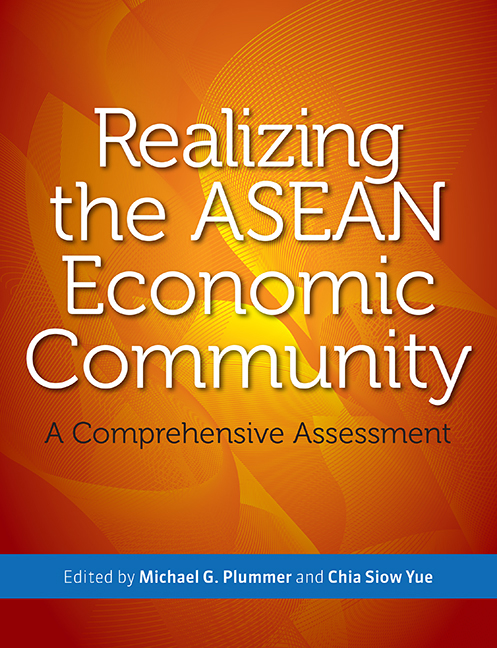Book contents
- Frontmatter
- Contents
- Illustrations
- Foreword
- Executive Summary
- Acknowledgements
- About the Contributors
- 1 Introduction
- 2 Regional Market for Goods, Services, and Skilled Labor
- 3 Competition Policy, Infrastructure, and Intellectual Property Rights
- 4 The AEC and Investment and Capital Flows
- 5 Narrowing the Development Gap in ASEAN
- 6 Competitiveness and Leverage
- 7 Benefits of the AEC
- References
- Appendix A AEC Components
- Appendix B The CGE Model
- Appendix C Developments in Logistics and Aviation
- Appendix D AEC Blueprint Excerpt
- Appendix E ASEAN Free Trade Agreements
- Appendix F ASEAN Member States' Free Trade Agreements
- Appendix G ASEAN Imports and Exports, 2000 and 2006
- Index
2 - Regional Market for Goods, Services, and Skilled Labor
Published online by Cambridge University Press: 21 October 2015
- Frontmatter
- Contents
- Illustrations
- Foreword
- Executive Summary
- Acknowledgements
- About the Contributors
- 1 Introduction
- 2 Regional Market for Goods, Services, and Skilled Labor
- 3 Competition Policy, Infrastructure, and Intellectual Property Rights
- 4 The AEC and Investment and Capital Flows
- 5 Narrowing the Development Gap in ASEAN
- 6 Competitiveness and Leverage
- 7 Benefits of the AEC
- References
- Appendix A AEC Components
- Appendix B The CGE Model
- Appendix C Developments in Logistics and Aviation
- Appendix D AEC Blueprint Excerpt
- Appendix E ASEAN Free Trade Agreements
- Appendix F ASEAN Member States' Free Trade Agreements
- Appendix G ASEAN Imports and Exports, 2000 and 2006
- Index
Summary
The AEC Blueprint calls for creating a single market and production base by achieving a free flow of goods, services, and skilled labor. AFTA had done much to integrate ASEAN's goods market but far less has been done for services and skilled labor. Goals of the AEC include reducing transaction costs associated with trade in goods and services, attracting FDI through nondiscrimination and best practices, and enabling the free movement of skilled labor throughout the region. These are ambitious goals but potentially well worth the effort. If they are met the private sector will benefit from an integrated regional market, rather than a series of individual national ones.
This chapter will delineate various measures required to complete the task of establishing free flow of goods, services and skilled labor as articulated in the AEC, evaluate the likely economic effects that will derive from a successful implementation of these measures, and consider how they will affect various stakeholders and their likely impact on the success of the AEC itself. We conclude that extending AFTA to include the elimination of NTBs and trade facilitation measures should generate considerable economic benefits — on the order of 5.3 percent of ASEAN GDP (under conservative assumptions). It is difficult to quantify the likely effects of the free flow of skilled labor, but theory suggests that rationalizing the division of labor in ASEAN and enabling skilled labor to function as input for FDI promises considerable economic gain.
FREE FLOWS OF GOODS: A SURVEY OF THE ISSUES
Following the principle of economic theory that benefits accrue if goods and services cross borders uninhibited by artificial barriers, the AEC aims to create a single market and production base in which transaction costs are minimized and trade gains maximized. A trading region so unified will facilitate development of production networks, exploit fragmented trade opportunities, and become a global production center or at least central to global supply chains.
- Type
- Chapter
- Information
- Realizing the ASEAN Economic CommunityA Comprehensive Assessment, pp. 20 - 57Publisher: ISEAS–Yusof Ishak InstitutePrint publication year: 2009

